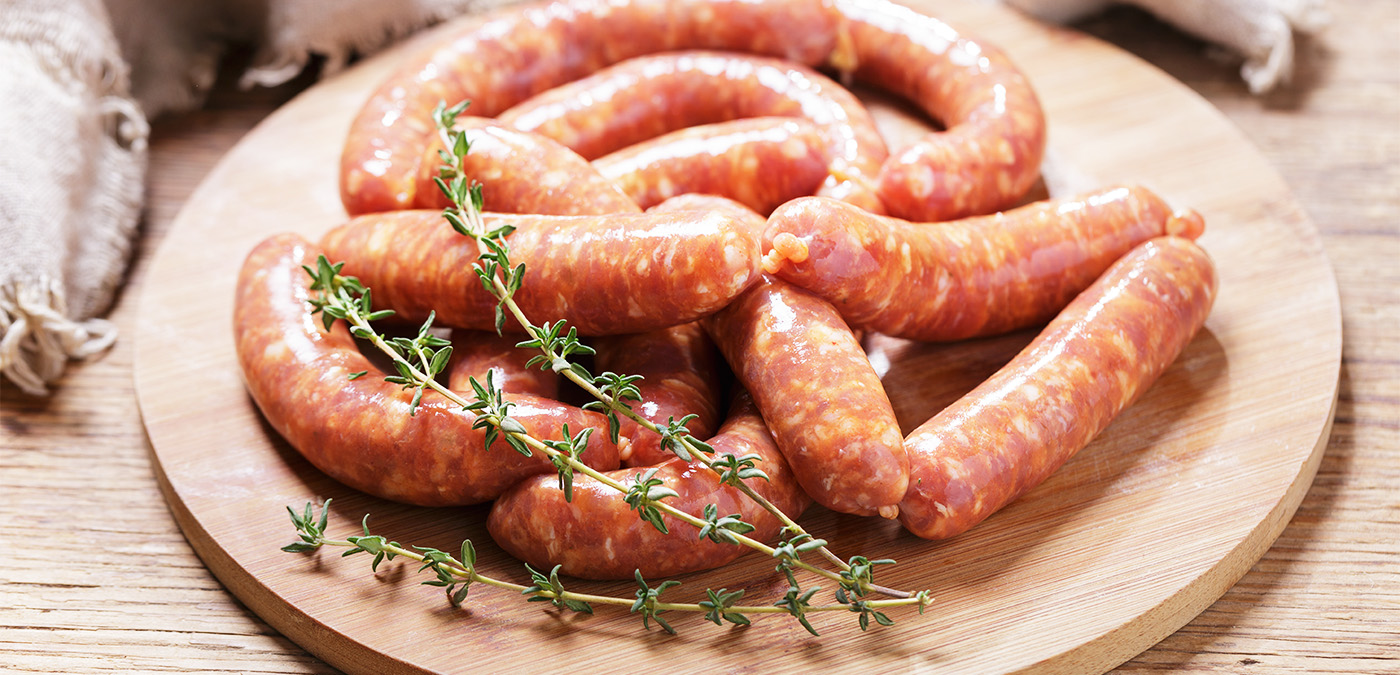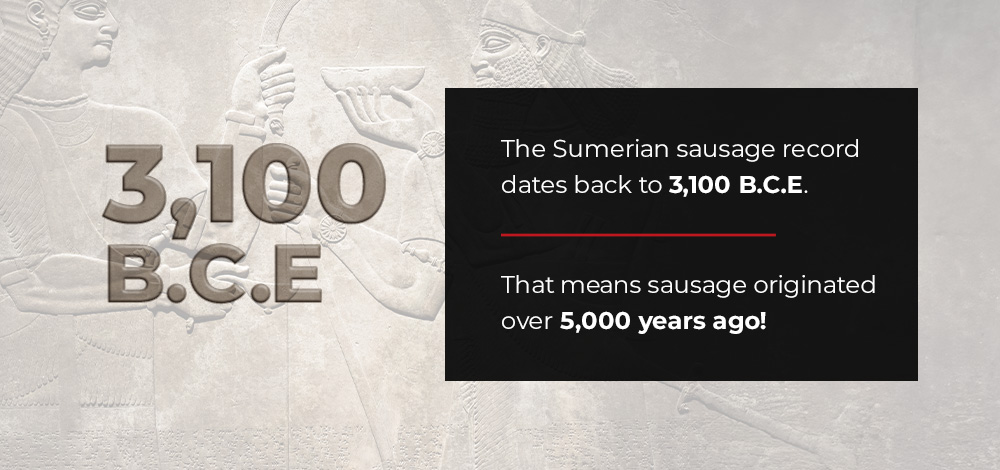Origin of Sausage: Where Did Sausage Come From?

Sausage is one of America’s favorite foods, with over 254 million Americans projected to eat sausage by the end of 2024. But the popularity of sausages goes far beyond the United States’ borders.
Sausage is a universal cuisine, with virtually every nation on earth having its distinctive take on the dish. With so many variations, what does it mean to call a food “sausage,” and what are the origins of this meaty delight? Keep reading for an appetizing overview of 5,000 years of sausage history!
What Is Sausage?
The word “sausage” was first used in the 15th century, though it was originally spelled “sausige” in Middle English. It’s related to the French word “saucisse,” but it ultimately traces back to the Latin word “salsicia,” which means “seasoned with salt.”
Sausage is a meat product that fills chopped or ground, seasoned meat into a cylindrical casing. Most traditional sausage casings are made from an animal’s intestine. Historically, forming meat into well-salted, spiced sausages was a way of preserving it.
The meat itself could come from any animal, though beef, pork and poultry are most popular. Today, even vegetarian and vegan sausages are gaining ground!
The History of Sausage
Today’s sausages have links stretching over thousands of years to the ancient world. Let’s explore sausage’s origin and development through the ages.
Where Does Sausage Come From?
The oldest records of sausages come from ancient Mesopotamia, a Middle Eastern territory occupying the land we now know as Iraq.
Archaeologists have discovered Sumerian wall carvings depicting people placing salted meat into cleaned animal intestines. A written tablet from this region also describes a dish made by stuffing meat into intestinal casings.
This makes Mesopotamia the birthplace of the sausage. Ancient Greek, Roman and Chinese sources also show early evidence of sausages.
Who Invented Sausage?
The earliest evidence doesn’t record an individual inventor. However, it does indicate that the Sumerians of Mesopotamia were the first to prepare sausages.
When Was Sausage Invented?

The Sumerian sausage record dates back to 3,100 B.C.E. That means sausage originated over 5,000 years ago! The European sausage tradition began in the Greco-Roman world.
Sausages were popular among Greeks by 800 B.C.E. Homer’s “The Odyssey,” composed around this time, includes a poetic description of a man grilling a fat and blood-filled goat sausage. Another highlight in the literary history of sausages came when Epicharmus, dubbed the “Prince of Comedy” by Socrates, wrote a play called “Orya” or “The Sausage.”
Chinese history records the emergence of lap cheong sausage during the Northern and Southern Dynasties, around 420-589 C.E. The original lap cheong recipe consists of goat and lamb meat seasoned with salt, green onion, bean sauce, ginger and pepper. Doesn’t that still sound delicious 1,500 years later?
It’s difficult to know whether sausage-making secrets were passed along from one nation to another after Sumerians first invented sausages. It’s plausible that several independent people throughout the ages discovered the delicious idea of sausage for themselves.
Sausage Through the Centuries
Sausages have continued to develop and diversify over their long history. Here are several sausage history highlights:
- 3,100 B.C.E.: The first evidence of sausage is depicted in Sumerian wall carvings.
- 1,700 B.C.E.: An Akkadian tablet from the same region contains the first written sausage recipe.
- 800 B.C.E.: Homer describes an early sausage barbecue in “The Odyssey.”
- 500 B.C.E.: Epicharmus writes “Orya.”
- 228 C.E.: A Roman cookbook records that pork sausages with pine nuts were a favorite during the ancient festival of Lupercalia.
- 420-589 C.E.: The Northern and Southern Dynasties period contains records of the lap cheong goat and lamb sausage recipe.
- 1,487 C.E.: The Frankfurter sausage is invented in Germany.
- 1,522 C.E.: During “The Affair of the Sausages,” Swiss Reformer Huldrych Zwingli defends people imprisoned for eating sausage during the Lenten fast.
- 1,700s C.E.: The modern recipes for salami — salted, spiced and air-dried beef or pork sausage — gain popularity in Italy, drawing on a centuries-old Roman salty sausage tradition.
- 1,904 C.E.: Anton Ludwig Feuchtwanger of Bavaria introduces frankfurters to Americans at the World’s Fair.
- Today: The global sausage market is worth $111.6 billion as people all over the world enjoy sausages made from every kind of meat or no meat at all.
Sausages Around the World
We’ve already seen how people across the globe have enjoyed sausages for centuries. Here are some more entries for your sausage atlas:
- Italy: There’s more to Italian sausage than your average salami. Authentic Italian sausages are carefully flavored for a variety of profiles from sweet and mild to hot. Distinctive herbs like sweet basil make Italian sausage a vibrant experience for your palate. True Italian sausage has just the right amount of fat to remain sumptuously moist when you cook it for your family.
- Germany: We’ve mentioned frankfurters, but bratwurst is an equally iconic traditional German sausage. Bratwurst is usually made from chopped pork, generously spiced. It originated as an efficient way to prepare meat to last through the tough German winters.
- France: Andouille sausage is a fragrant pork chitterling sausage. Its intense aroma is a familiar favorite among fans of French and Cajun cuisines, but it may be overwhelming to others. Cajun dishes bring out Andouille’s smoky flavors. This sausage has become a staple ingredient in Louisiana.
- Mexico: Chorizo sausage emerged when culinary explorers combined Spanish pork with Mexican chili peppers for a bold, flavorsome sausage. Today, Mexico and Spain each have their own distinctive take on chorizo. Mexican chorizo is made from fresh pork with ample fat, seasoned with herbs, spices, chili and vinegar. After careful casing and patient air-drying, you have a perfect spicy sausage to serve with eggs, beans or your side of choice.
- Thailand: Thai cuisine has many regional varieties of the nation’s traditional sausage — Sai Ua. Its name means “stuffed intestine.” Classic Sai Ua is made from ground pork with a red curry paste and herb seasoning. Grilled Sai Ua with sticky rice is a popular Thai appetizer.
Taste the Way Sausage Should Be
Premio Foods has been crafting authentic Italian sausages from quality meat for over 40 years. Our Italian tradition links back through the centuries to the ancient origins of sausage — the food that unites the world.
We use only the finest pork and chicken, seasonings and spices to bring the familiar, juicy delight of Italian sausage fresh to your taste buds. The family recipes for Premio sausages have been handed down and refined through generations. From the founding family’s original home in Naples, Italy, Premio brings this mouthwatering legacy to your home.
Use our store locator to find Premio sausage near you. It’s time your family enjoyed authentic Italian sausage the way it should be.

